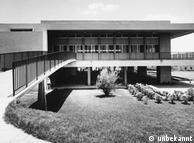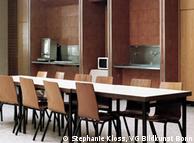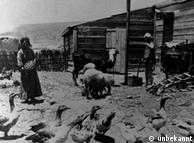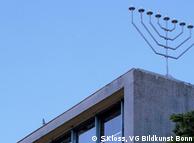ARCHITECTURE | 18.01.2012
Bauhaus came to life in Tel Aviv
For the Jewish settlers who emigrated from Europe to Palestine in the 1920s and 30s, the kibbutz presented a new way of living, a community and a safe haven. It represented a utopia - free from persecution, pogroms, deportations and patriarchal structures.
This new form of communal living - a radical and voluntary application of socialist principles - also necessitated new forms of housing. Their buildings were strongly influenced the ideas of Germany’s Bauhaus movement, which also championed an anti-bourgeois spirit.
The legendary Bauhaus school, which was founded in Weimar in 1919 and later moved to Dessau, aimed to abolish the distinction between artist and craftsman. This open-minded ideology irritated the Nazi regime and in 1933 the group succumbed to pressure and disbanded. But the Bauhaus movement was already considered the embodiment of modernity, especially in architecture.
 The dining hall in Kibbutz Mechavia, viewed in the 1930sNew materials such as reinforced concrete and architectural features like flat roofs and sober white facades were typically associated with Bauhaus. All this can be found in Tel Aviv, which is known even outside of Israel as "the Bauhaus city."
The dining hall in Kibbutz Mechavia, viewed in the 1930sNew materials such as reinforced concrete and architectural features like flat roofs and sober white facades were typically associated with Bauhaus. All this can be found in Tel Aviv, which is known even outside of Israel as "the Bauhaus city."
However, Philipp Oswalt, director of the Bauhaus Foundation in Dessau which is currently hosting the exhibition "Kibbutz and Bauhaus," told Deutsche Welle that this description is not entirely true. He explained Tel Aviv was much more influenced by Edward Le Corbusier, a Swiss architect and designer who helped shape much of the architecture of the first half of the 20th century. Still, Bauhaus is very much part of Israel, but in ways other than what one might expect.
According to Hannes Meyer, the Bauhaus director from 1928 to 1930, the purest expression of Bauhaus architecture can be found in the kibbutzim - not so much in the architectural style, but in how the community buildings were realized.
The architect Arieh Sharon, who left Palestine to study for some years at the Bauhaus school, returned to make his mark on the kibbutz. It wasn't his architectural style which was influential, but his implementation of the socialist building principles, according to Meyer.
 The dining hall in Kibbutz MizraIncluded in the exhibition are photos depicting the angular, cube-shaped concrete buildings with large windows with a functional, open space inside that can be converted easily into a theater or performance venue. But Sharon was only one from 18 former Bauhaus members who contributed to the design of the kibbutzim.
The dining hall in Kibbutz MizraIncluded in the exhibition are photos depicting the angular, cube-shaped concrete buildings with large windows with a functional, open space inside that can be converted easily into a theater or performance venue. But Sharon was only one from 18 former Bauhaus members who contributed to the design of the kibbutzim.
Nothing was spontaneous and everything was planned carefully, even though many of the fundamental democratic decisions must have been difficult to reach. Many of the architectural decisions were never agreed on until all the kibbutz members were satisfied.
The kibbutz roof was often an area of contention between architects and collective owners of the kibbutz.
In his film "Traces," director Amos Gitai recalls how his father, the Bauhaus architect Munio Weinraub, often had to use his great powers of persuasion to convince the kibbutz residents to accept a modern flat roof and not a pointed one reminiscent of their cold European homelands.
Weinraub escaped the Nazis via Switzerland in 1936 and came to Israel. There, he built theaters and museums, which gave the kibbutzim a more urban feel.
A thing of the past?
 The first Kibbutz, known as Degania, was founded in 1910Even in the 30s, the heyday of the kibbutzim, only 10 percent of the Jewish immigrants lived in this type of home. Today there is little interest in the kibbutzim, even though they have long given up their ideals of a collective utopia.
The first Kibbutz, known as Degania, was founded in 1910Even in the 30s, the heyday of the kibbutzim, only 10 percent of the Jewish immigrants lived in this type of home. Today there is little interest in the kibbutzim, even though they have long given up their ideals of a collective utopia.
Most opt for more privacy in their living spaces. The special children's houses are gone and the kids once again sleep at their parents' home.
The photos of decaying dining halls are sad images. The few collective communities that still exist today rely mainly on tourists. And yet, the current crisis facing Israel has awakened a new interest in the various forms of community life. This exhibition gives a vivid account of just how enthusiastic the world once was about the Bauhaus movement.
Author: Andrea Kasiske / bos
Editor: Kate Bowen


No comments:
Post a Comment